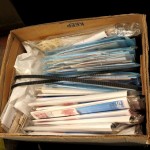 I’ve been trying to avoid having a paper wing since it might be heavier and more costly than tissue.
I’ve been trying to avoid having a paper wing since it might be heavier and more costly than tissue.
But the wing framing onto tissue paper is trickier with interlocking parts.
But I think I found an alternate way of getting the wing structure to work and fix this issue of interlocking parts.
In a nutshell the leading and trailing edge only run most of the way out to the wing tips. They are short by about an inch. There is also no wing tip ribs! There’s a little less wood so the weight penalty may not be there. Also the aileron and winglet glue seams are dropped.
I’m going to get to one of the labs and cut out another laser design and print this template.
I think this will be interesting. If there is rigidity issues I will look at a curved airfoil and see if I can find an easy way to use that to make the wing better.








































